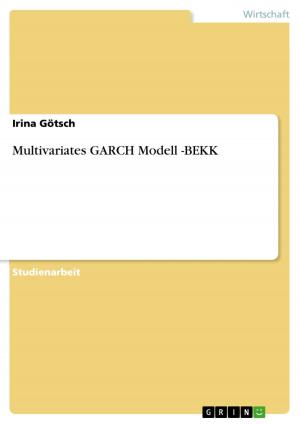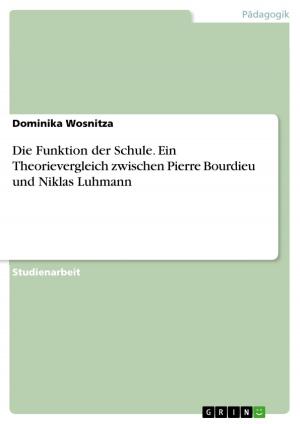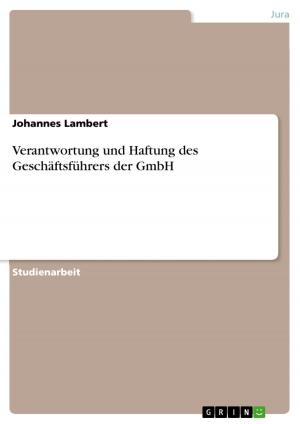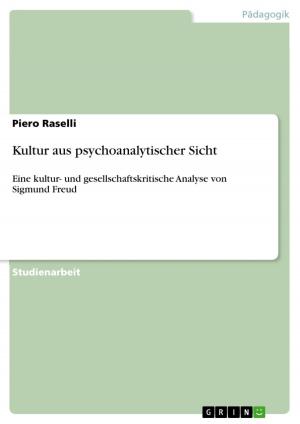Conrad and Coppola and the Heart of Darkness Within:The Symbolic Value of Darkness in Heart of Darkness and Apocalypse Now
Fiction & Literature, Anthologies| Author: | Silke Weishaupt | ISBN: | 9783638271158 |
| Publisher: | GRIN Verlag | Publication: | April 24, 2004 |
| Imprint: | GRIN Verlag | Language: | English |
| Author: | Silke Weishaupt |
| ISBN: | 9783638271158 |
| Publisher: | GRIN Verlag |
| Publication: | April 24, 2004 |
| Imprint: | GRIN Verlag |
| Language: | English |
Seminar paper from the year 2003 in the subject English Language and Literature Studies - Comparative Literature, grade: 1,7 (A-), University of Bayreuth (English Literature), course: Literature and Media Transformations, language: English, abstract: 'When a great artist in one medium produces a work based on a masterpiece in the same or other medium, we can expect interesting results' (E. N. Dorall: Conrad and Coppola: Different Centres of Darkness). In his essay The Rethoric of Narrative in Fiction And Film, film critic Seymore Chatman observes that 'a lot of ink has been spilled in recent years on film adaptations of novels (...). Too much of the discussion has centred on questions of story content, with particular respect to 'fidelity', as if the source novel were some sacrosanct object whose letter as well as spirit the film had to follow.' He continues that this approach 'often leads to an unproductive prescriptivism that finds the film inadequate because it does not 'read' like the novel'. It seems that John Milius and Francis Ford Coppola who both wrote the screenplay for the movie Apocalypse Now, had the same thoughts in mind when they decided to adapt Conrad's novel Heart of Darkness -as Milius stated himself - 'in some shape or form'. They certainly did not want to spill any ink and he also did not see the novel as a sacrosanct object. Apocalypse Now is not a conventional film adaptation of Conrad's novel since -at least at first glance- it does not pay particular respect to 'fidelity'; a Vietnam war movie does not seem to have much in common with a novel written in 1898 and dealing with colonialism. However, it is said that HD can be seen as the 'root' for AN, because 'a seventeen-year old John Milius heard his English reader, Irwin Blackter, extol the splendour of Conrad's novel Heart of Darkness'. And if we take a closer look at the movie, the parallels to Conrad's novel become obvious. This essay will be divided into two major parts. The first one of will focus on the comparison of the plot and narrative structure of HD and AN. It will establish a general overview of the formal aspects of novel and film as well as of the similarities of characters appearing in both HD and AN. Special attention will be paid to the symbolic value of the plot of the story- the metaphorical meaning of darkness- appearing in both Conrad's novel and Coppola's movie and the question of how and why the screenplay-writers of AN applied Conrad's ideas on their film adaptation. The second part will be with special focus on Coppola's film adaptation of Conrad's novel. The analysis of several scenes will pay special attention to details of techniques for visualisation and sound used by Coppola to depict the plot.
Seminar paper from the year 2003 in the subject English Language and Literature Studies - Comparative Literature, grade: 1,7 (A-), University of Bayreuth (English Literature), course: Literature and Media Transformations, language: English, abstract: 'When a great artist in one medium produces a work based on a masterpiece in the same or other medium, we can expect interesting results' (E. N. Dorall: Conrad and Coppola: Different Centres of Darkness). In his essay The Rethoric of Narrative in Fiction And Film, film critic Seymore Chatman observes that 'a lot of ink has been spilled in recent years on film adaptations of novels (...). Too much of the discussion has centred on questions of story content, with particular respect to 'fidelity', as if the source novel were some sacrosanct object whose letter as well as spirit the film had to follow.' He continues that this approach 'often leads to an unproductive prescriptivism that finds the film inadequate because it does not 'read' like the novel'. It seems that John Milius and Francis Ford Coppola who both wrote the screenplay for the movie Apocalypse Now, had the same thoughts in mind when they decided to adapt Conrad's novel Heart of Darkness -as Milius stated himself - 'in some shape or form'. They certainly did not want to spill any ink and he also did not see the novel as a sacrosanct object. Apocalypse Now is not a conventional film adaptation of Conrad's novel since -at least at first glance- it does not pay particular respect to 'fidelity'; a Vietnam war movie does not seem to have much in common with a novel written in 1898 and dealing with colonialism. However, it is said that HD can be seen as the 'root' for AN, because 'a seventeen-year old John Milius heard his English reader, Irwin Blackter, extol the splendour of Conrad's novel Heart of Darkness'. And if we take a closer look at the movie, the parallels to Conrad's novel become obvious. This essay will be divided into two major parts. The first one of will focus on the comparison of the plot and narrative structure of HD and AN. It will establish a general overview of the formal aspects of novel and film as well as of the similarities of characters appearing in both HD and AN. Special attention will be paid to the symbolic value of the plot of the story- the metaphorical meaning of darkness- appearing in both Conrad's novel and Coppola's movie and the question of how and why the screenplay-writers of AN applied Conrad's ideas on their film adaptation. The second part will be with special focus on Coppola's film adaptation of Conrad's novel. The analysis of several scenes will pay special attention to details of techniques for visualisation and sound used by Coppola to depict the plot.















